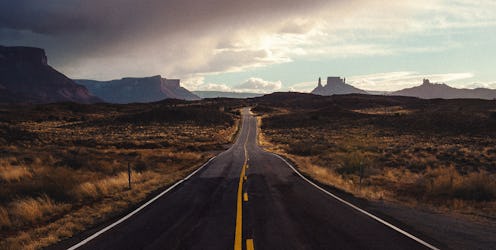
Are you going on a road trip for spring break? If yes, you'll want to see this: Data scientist Randy Olson has calculated the ultimate road trip route for the United States. How does one do that? With a little help from technology, of course — but it's still pretty cool. Check it out.
This isn't the first time we've encountered Olson's work; in addition to the graphs he made to illustrate a study exploring whether age matters in a relationship, he's widely known across the Internet for coming up with the optimal strategy with which to find Waldo of Where's Waldo? fame. This time, Discovery News' Tracy Staedter approached him about putting his know-how to use planning the ultimate road trip — and, naturally, he rose magnificently to the occasion.
I've typically referred to Olson as a data scientist when discussing his work, which is, in fact, accurate; however, Ana Swanson at the Washington Post dubbed him a “data tinkerer,” which is now my new favorite job description. It's spot on, too — Olson's projects are fueled by curiosity, and with the goal being to use the data available out there in the big, wide world to help us understand that big, wide world. How do you that? By tinkering around with the numbers and figures until you finally uncover what it's trying to tell you. I am terrible at juggling numbers myself, but I find the results of such experiments fascinating — which is why I'm glad there are people like Randy Olson out there who can not only do the calculations, but also explain them in ways that make sense to the scientific laypeople among us (that is, me).
Anyhoo, here's what Olson came up with:
The Ground Rules:
As Olson wrote on his website, initially he and Staedter needed to lay out a few rules for their hypothetical adventure:
- The trip has to make at least one stop in all 48 contiguous states in the U.S. (sorry, Alaska and Hawaii).
- Stops will only be made for National Natural Landmarks, National Historic Sites, National Parks, or National Monuments.
- The trip must be made by car; furthermore, it can never leave the U.S. (so no crossing over into Canada or Mexico).
From there, Staedter came up with a list of 50 stops — 48 to fit the one stop per state requirement, plus one in Washington, D.C. and an additional one in California — which includes everything from Yellowstone to the White House. You can see the full list over at Discovery News, but a few of my favorites include the following:
- Pike's Peak, Colorado
- The Alamo, Texas
- Elvis Presley's Graceland, Tennessee
- The French Quarter, New Orleans, Louisiana
- Cape May Historic District, New Jersey (speaking from experience: Go there during the winter holidays. It's gorgeous.)
- Abraham Lincoln's Home, Illinois
- Gateway Arch, Missouri
- C. W. Parker Carousel Museum, Kansas
The Method:
Now we get to the tricky bit: Actually figuring out the optimal route by which to see all these awesome things we have hanging out in our country. Obviously Olson had to stick to roads — that is, he couldn't just draw a straight line between each landmark — so he harnessed the power of Google Maps. Because looking up all the directions manually would have taken roughly until the end of time, he wrote a Python script and paired with the Google Maps API. The results? Nicely calculated distances and time driven for all 2,500 possible routes between the 50 landmarks. Isn't technology great?
The biggest challenge, though, was solving a classic “traveling salesman problem”: How can you visit all those landmarks, in order, while keeping the distances between them as small as possible? According to Olson, this involves “finding a route that backtracks a little as possible,” something which gets to be rather difficult around Florida and the Northeast.
This is about where Olson's explanation starts to the get the best of me; I have no head for numbers, and this bit is all numbers. From what I gather, though, the trick is accepting that you're not going to use the “absolute best” route between each stopping point. Once you do that, you can use something called genetic algorithms — the technique Olson used to solve the Waldo problem — and find a solution that's “good enough.” The algorithm Olson used calculated the solution in less than a minute, so hoorah for that.
The Results:
Here's the trip by numbers:
- 13,699: The total number of miles traveled using Olson's ultimate road trip path.
- 224: The number of hours of driving total, assuming there's no traffic.
- 9.33: The number of days all those hours come out to.
- 2 to 3: The approximate number of months the trip will take if you stop to eat, sleep, actually visit the sites on your list, and so on.
The route looks a little something like this:
Oh, and hey, guess what? Olson created an interactive version of the map (which is what I've screen-grabbed here for you) via Google Maps. Head over there to check it out — it's pretty cool.
So there you have it. Of course, if your idea of an awesome road trip doesn't involve any national landmarks, you can tweak the algorithm as necessary until it hits all the spots you do want to visit (supposedly haunted places, perhaps?). Olson went ahead and created another map for road tripping to popular U.S. cities according to TripAdvisor's top-rated cities in each state, as well as for a number of places in Europe, so head on over to his website to check them out. Happy travels!
Images: Geoff RT Ficiel/Flickr; Giphy (3); Randy Olson/Google Maps